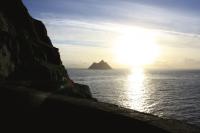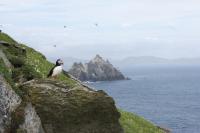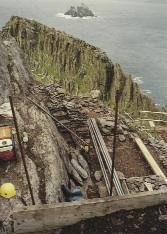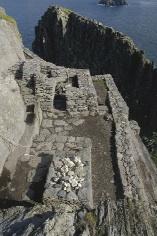Radio ear : Skelligs calling
Published in 20th-century / Contemporary History, Issue 1(Jan/Feb 2012), Reviews, Volume 20
A view of Small Skellig from Skellig Michael—surely the most rugged and striking of Ireland’s islands. (Edward Bourke)
The sandstone peaks of the Skelligs loom out of the Atlantic seven miles off the coast of south-west Kerry, of which they are a geological extension—an almost ironic connection, given how utterly divorced the Skelligs now are from the human life of the mainland. The hardship of life on the neighbouring Blasket Islands was immortalised in the classic autobiographies of Tomás Ó Criomhthain, Muiris Ó Súilleabháin and Peig Sayers. But there are no comparable accounts from what are surely the most rugged and striking of Ireland’s islands, let alone Kerry’s. Skelligs calling, produced by Kevin Brew and Luke Clancy, could not bridge this gap; what it could and did do was bring listeners on a striking aural journey through the ecology and landscape of the Skelligs.The key figure here was Chris Watson, a native of Sheffield (and former member of Cabaret Voltaire) who has, over the past two decades, become one of the world’s leading sound-recordists in the field of natural history.

At the landing point Watson recorded the extraordinary sounds of the thousands of sea birds swarming around the summit, and even those—puffins—burrowing within it. (Edward Bourke)
Here, he satisfied a lengthy fascination with the Skelligs and recorded the extraordinary panoply of sounds generated by both the wildlife and landscape of the islands. This documentary was, quite literally, aural history. The Skelligs lie on the fringes of the Atlantic: to illustrate the point, Watson presented the remarkable sound of currents breaking around the Skelligs on the basis that such currents may have originated as far away as Newfoundland. Humans settled on Skellig Michael, the larger of the two islands, as early as the sixth century. An unknown abbot and his followers decamped to a mountain in the ocean; the current name reflects the significance of St Michael as the patron of high places, but the island may well have had a pre-Christian significance. The monastery was to be an exemplar of devotion for Christians, presenting an extraordinary physical challenge that was to lead to a spiritual challenge; for both God and the Devil were to be found at the edge of the known world, and a network of such monasteries existed across the Atlantic fringe of Latin Christendom. That the Skelligs represented perhaps the most extreme sanctuary of such monasticism was one of the stated reasons why UNESCO designated it a World Heritage Site in 1996 (although the forbidding location had not stopped Vikings from raiding the monastery in the ninth century).

The South Peak oratory immediately after archaeological excavation.
Much of the documentary was structured around Watson’s ascent of the 618 vertiginous steps that lead up to the famous monastery on Skellig Michael’s peak; the larger of the two islands was the main focus of the programme. Watson’s attitude and approach were reminiscent of another sensitive English chronicler of Ireland’s landscape, the writer and cartographer Tim Robinson. Unlike Robinson, however, Watson dealt in sounds. To give but one example, the Skelligs house massive colonies of seabirds, some of global significance—kittiwakes, guillemots, Manx shearwaters, puffins, razorbills, storm petrels—and at the landing point Watson recorded the extraordinary sounds of the thousands of sea birds swarming around the summit, and even those (the puffins) burrowing within it. Watson’s remarkable ability to conjure images infused with the sheer physicality of the sounds he encountered, and to do so with a palpable sense of wonder, made this documentary stand out. The emphasis on what could be heard gave it something of a timeless quality. Despite the fact that the monastery was abandoned centuries ago, one could get a real sense of the soundscape that its inhabitants would have experienced. There is a slightly bizarre caveat to be entered, though: the archaeologist Michael Gibbons pointed out that the sheer quantity of birds would have ensured a ready supply of food. Despite the hardships presented by their environment, the monks may well have been very well fed, and thanks to the absence of human habitation in the present day Watson was recording an island that is probably far noiser than it once was.

After reconstruction, an example of the recent restoration work that has proven controversial. (Michael Gibbons)
The natural soundscape was augmented by a range of voices expounding upon aspects of the human history of the Skelligs, but the documentary did have one unfortunate flaw: a tendency to strive for an almost breathless profundity that seemed a tad hollow at times. Newstalk’s Talking History hosted an illuminating discussion on the history of the Skelligs last February; had some of the fascinating archaeological and historical detail revealed there been deployed here—and some of the same contributors appeared on both programmes—it would have strengthened Skelligs calling quite considerably. After all, the Skelligs have been a focal point for innumerable imaginations over the centuries, but it is surely worth reflecting upon the realities of everyday life for those who once lived there. For example, there are no natural springs on Skellig Michael, but alongside (and under) the famed complex of beehive huts is a sophisticated network of cisterns. Here was an organised society, arranged in a tiny urban settlement, and it survived for at least 600 years. The visible remnants of the site are the youngest constructions, but traces of older settlements remain, such as a recently discovered flight of steps leading from the sea on the north-east of the island. Such remains surely cannot be divorced from what were, presumably, the ascetic motives behind building them.The hostility of the Skelligs’ environment has been highlighted by a number of tragic fatalities in recent years, and the issue of safety for visitors naturally poses questions about the future management of the islands by the Irish authorities. The manner in which preservation and restoration work has been undertaken on the Skelligs has proven extremely controversial in the recent past (see HI 15.3, May/June 2007; HI 16.1, Jan/Feb. 2008), even attracting criticism from UNESCO itself. Given that the Irish state is suddenly rediscovering the value of heritage tourism amidst our present discontents, whilst also coming up with ludicrous suggestions to remove statutory protection from anything built after 1700, one has to wonder at how aspects of Ireland’s heritage will fare in an uncertain future. The Skelligs retain an extraordinary element of that heritage. This documentary, and Watson’s recordings, offered a fascinating sonic portrait of these most remarkable of islands. HI
Skelligs calling is available on-line at http://www.rte.ie/radio1/doconone/radio-documentary-skelligs-calling-michael.html
















